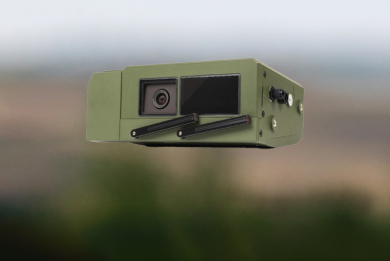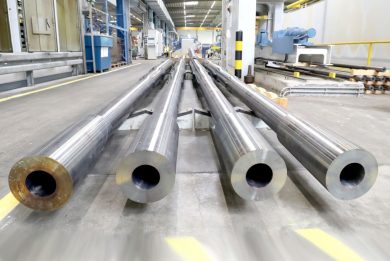
Rheinmetall Italia, the growing arm of the Düsseldorf group
To meet the increasing demand for air defence systems, Rheinmetall Italia is refurbishing its facility in Rome to increase the production of radars, guns and command and control elements of the different air defence systems of its portfolio
The origin of what is today Rheinmetall Italia dates back to 1952, when Contraves Italia was created in Rome as a subsidiary of Contraves AG in Zurich, the Italian company active in the short-range air defence systems. In the 1960s it started to deal with radars. In those same years Oerlikon Italiana, a subsidiary of Swiss Oerlikon AG, was founded in Milan in 1948, and in the 1960s it also started to deal with defence products, mostly medium calibre cannons. It also produced mechanical components for Contraves Italiana. In 1993 the two Swiss mother companies merged which led to the creation of Oerlikon Contraves S.p.A. In 1999 it was acquired by Rheinmetall, becoming Rheinmetall Italia in 2007.
In the current Rheinmetall Group organisation, Rheinmetall Italia is part of the Electronics Solutions division and it falls under the Air Defence and Radar Systems business unit, which is composed of Swiss-based Rheinmetall Air Defence and Rheinmetall Italia. It is worth mentioning that the latter is not the only Rheinmetall company based in Italy that deals with defence issues; RWM Italia, based in Brescia, is also active in the weapons and ammunitions business, a further operation that deals with the automotive sector. Overall, the Rheinmetall Group has six facilities in Italy, with around 2,000 employees and an annual revenue of 1 billion Euro.
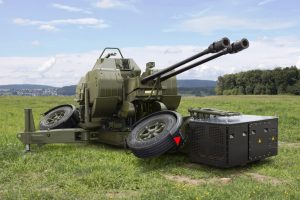
Rheinmetall Italia is focused on very short- and short-range air defence and it has sold over 600 gun-based Skyguard air defence systems, some integrated with missiles, and more than 5,000 guns all over the world. The company has achieved 60 export customers. Based on the 35 mm GDF gun in its various models, Skyguard systems are still in service; the latest version of them was sold to a Middle East country no more than 10 years ago. The company ensures the maintenance and upgrade of the whole system including radars and fire control systems, which were designed and produced in Rome.
Due to its heritage, Rheinmetall Italia is in fact the radar house of the Düsseldorf group, and in the 1980s it produced the radar for the ADATS (Air Defense Anti-Tank System), the dual-use system acquired by the Canadian Army and in small quantities by the United States. The system was produced in cooperation with Oerlikon AG and Lockheed Martin with the aim of defeating helicopters and armoured vehicles. In the 1980s the Rome facility reached a peak manpower of around 1,500 employees. After the end of the Cold War, in the 1990s manpower was dramatically reduced to less than 300 people; the company was reshaped, while retaining key capabilities and outsourcing many other operations.
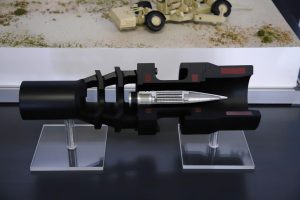
The acquisition by Rheinmetall marked a period of heavy investments in technology and cooperation with Zurich was strengthened. The advent of the AHEAD (Advanced Hit Efficiency And Destruction), initially developed as an anti-missile round and whose technology is now used in the KETF (Kinetic Energy Time Fused) ammunition used in counter-drone systems, led what would soon become Rheinmetall Italia to develop radars capable of detecting small targets. This has led to some cooperation with third parties, for example with MBDA on the Mistral command post.
In the early 2000s Western armies were mostly engaged in operations other than war and were facing what was known as the RAM threat, the acronym for rocket artillery and mortar. Rheinmetall met the demand of a Counter-RAM system (C-RAM in short) that would exploit in-house capabilities by combining AHEAD technology, the Millenium gun, capable of 1,000 rounds per minute, and radars. The system was acquired by the German Bundeswehr, where it is known as MANTIS (Modular Automatic and Network-capable Targeting and Interception System). Rheinmetall Italia provides both detection and tracking radars.
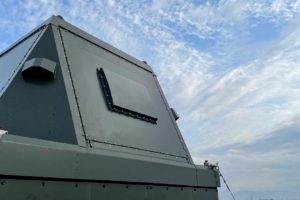
While maintaining a gun production capability, the Rome facility is mainly dedicated to electronics, focusing on radars. Today its main products are: the X-TAR3D software-defined pulse Doppler tactical acquisition radar, with an X-band vertical phased array with a rotating antenna, the AMMR AESA multi-mission radar operating in the S-band, and a family of tracking radars in X- or Ku-band. As for weapons, Rheinmetall Italia produces the Oerlikon KBA 25 mm automatic cannon, and integrates system based on 35 mm, like the Revolver Gun.
The recent changing in the European geopolitical situation and the increasing tensions in other parts of the world are bringing back defence on newspapers headlines. Rheinmetall Italia is seeing its workload increasing, its radars are at the center of Rheinmetall’s air defence products. The Italian-based company is also used as an alternate production company when Swiss export regulations, stricter than EU ones, do not allow the Oerlikon-based company to answer some customers’ requirements.
In recent times the Rheinmetall footprint in Italy has considerably increased; on one hand the agreement with Leonardo leading to the creation of the LRMV (Leonardo Rheinmetall Military Vehicles) joint venture for the production of main battle tanks and infantry fighting vehicles for the Italian Army, on the other Italy’s acquisition of one Skynex system, to be delivered within 2025, with an option for three more, will definitely increase the company’s business.

Ten percent value of the heavy vehicles will be produced in Rome; this includes part of the active protection system, the cannon autoloader, and some of the turret visual sensors for the MBT, while the involvement of Rheinmetall Italia in the IFV production will be mainly linked to the Skyranger 30 turret, as the Army is looking for an air defence/C-UAS version of the new platform; 47 vehicles of this type have been planned. As for the Skynex, most of the work will fall on the Rome-based arm of Rheinmetall.
The increased workload requires some investments in infrastructures and machinery. A building which remained unused since the 1990s when work decreased is now being demolished to build a wholly new state-of-the-art production facility; while the manpower is also expected to be increased, in fact the company currently employs 450-500 personnel.
Rheinmetall Italia has in-house capabilities to perform integration, qualification, and testing of air defence systems. Three anechoic chambers are available; the largest has an area of 10×10 metres and a height of 5 metres and uses far-field technology; the transponder is located on a tower at 250 metres distance. The most recent one uses near field technology, while the third one uses compact range technology, and is mainly used for production tests.
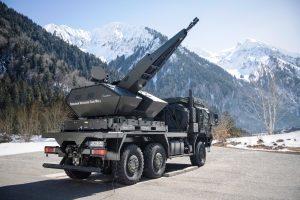
Detailing the Italian order for the Skynex, the Skymaster command and control will be the only manned element of the system, the shelter will house five or six personnel, usually the commander and four operators, each assigned to one gun. The C2 element is connected to the guns via fibreoptic or radiofrequency, the radar is the X-TAR3D, each Revolver gun has its tracking system based on a radar and an electro-optic device. The Italian Army will use the Skynex mainly for defending bases, all system elements will be carried on board 8×8 trucks with hook-lift capability. It should be noted that two Skynex systems have been delivered to Ukraine and two more are under delivery.
Software is becoming increasingly important not only in command and control but also with radars, allowing their easy upgrade and maintenance.
EDR On-Line understood that Rheinmetall Italia is working on artificial intelligence algorithms to improve radar performances, adopting a spiral approach whose first field of application is target classification, a first step in helping decision making. Here Rheinmetall Italia exploits synergies with the other entities of the group. Sharing of information within the Rheinmetall ecosystem allows savings and a shorter time-to-market.
Remaining in the radar domain, a tracking radar was installed directly on the Revolver Gun reducing errors and giving the system a full multiple target capability. As for the AESA Multi-Mission Radar, AMMR in short, this is proposed for VSHORAD/SHORAD systems; a possible customer is certainly the Italian Army on its Skyranger turrets.
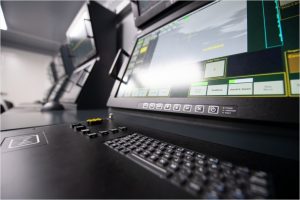
EDR On-Line was allowed to tour the Rheinmetall Italia production facility. Radar components are assembled in the electrostatic discharge (ESD) protected area, which is split into a “dirty” area and a clean room. Surface Mount Device (SMD) automatic line is organised in islands, quality checks are carried out at each step and all processes are recorded. Solder paste inspection (SPI) machines inspect printed circuit boards (PCB) to detect any defect in the solder paste printing before components are installed. The radar front-end requires very high accuracy, so pick-and-place machines are used for those PCBs, which allow ± 10 µm accuracy. Those machines can lace 2,000 components per hour, the average number of components for those PCBs is around 500. Removing humidity from components before storage in the computer-controlled oven, the vacuum process to remove voids between components and PCBs and continuous quality inspection are the key to ensure performances and reliability. Many operations are carried out in Class 7 clean rooms. The assembly time for a complete radar is several weeks.
The next step is mechatronic integration, also in this case constant tests are carried out during the process before reaching the anechoic chambers, where radars are turned on to test their performances.
The assembly areas where C2 shelters and guns are produced will be reorganised, as the mechanical workshop is being moved in another building, while the new building currently in construction will be organised with larger assembly islands; They are all similar, ensuring maximum production flexibility. A new 14.5 tonnes crane was recently installed, replacing the old 5 tonnes one, increasing flexibility. New product assembly lines have been separated from those for the guns and Skyguard C2 shelters which are being upgraded. While all electronic equipment can be tested in-house, for gun testing Rheinmetall Italia uses two main firing areas, the company-owned in Ochsenboden, Switzerland, and the Italian Army’s test range in Nettuno, about 40 km south of the company.
Photos courtesy Rheinmetall and P. Valpolini

